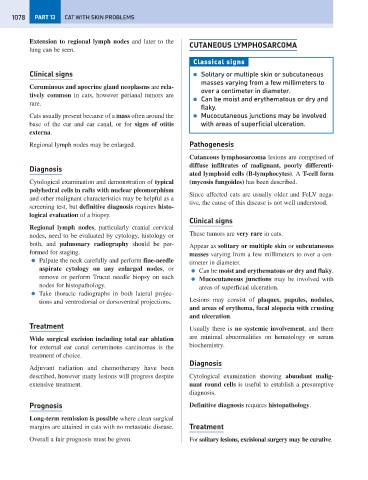Page 1086 - Problem-Based Feline Medicine
P. 1086
1078 PART 13 CAT WITH SKIN PROBLEMS
Extension to regional lymph nodes and later to the
CUTANEOUS LYMPHOSARCOMA
lung can be seen.
Classical signs
Clinical signs ● Solitary or multiple skin or subcutaneous
masses varying from a few millimeters to
Ceruminous and apocrine gland neoplasms are rela-
over a centimeter in diameter.
tively common in cats, however perianal tumors are
● Can be moist and erythematous or dry and
rare.
flaky.
Cats usually present because of a mass often around the ● Mucocutaneous junctions may be involved
base of the ear and ear canal, or for signs of otitis with areas of superficial ulceration.
externa.
Regional lymph nodes may be enlarged. Pathogenesis
Cutaneous lymphosarcoma lesions are comprised of
diffuse infiltrates of malignant, poorly differenti-
Diagnosis
ated lymphoid cells (B-lymphocytes). A T-cell form
Cytological examination and demonstration of typical (mycosis fungoides) has been described.
polyhedral cells in rafts with nuclear pleomorphism
Since affected cats are usually older and FeLV nega-
and other malignant characteristics may be helpful as a
tive, the cause of this disease is not well understood.
screening test, but definitive diagnosis requires histo-
logical evaluation of a biopsy.
Clinical signs
Regional lymph nodes, particularly cranial cervical
nodes, need to be evaluated by cytology, histology or These tumors are very rare in cats.
both, and pulmonary radiography should be per- Appear as solitary or multiple skin or subcutaneous
formed for staging. masses varying from a few millimeters to over a cen-
● Palpate the neck carefully and perform fine-needle timeter in diameter.
aspirate cytology on any enlarged nodes, or ● Can be moist and erythematous or dry and flaky.
remove or perform Trucut needle biopsy on such ● Mucocutaneous junctions may be involved with
nodes for histopathology. areas of superficial ulceration.
● Take thoracic radiographs in both lateral projec-
tions and ventrodorsal or dorsoventral projections. Lesions may consist of plaques, papules, nodules,
and areas of erythema, focal alopecia with crusting
and ulceration.
Treatment Usually there is no systemic involvement, and there
Wide surgical excision including total ear ablation are minimal abnormalities on hematology or serum
for external ear canal ceruminous carcinomas is the biochemistry.
treatment of choice.
Diagnosis
Adjuvant radiation and chemotherapy have been
described, however many lesions will progress despite Cytological examination showing abundant malig-
extensive treatment. nant round cells is useful to establish a presumptive
diagnosis.
Prognosis Definitive diagnosis requires histopathology.
Long-term remission is possible where clean surgical
margins are attained in cats with no metastatic disease. Treatment
Overall a fair prognosis must be given. For solitary lesions, excisional surgery may be curative.

